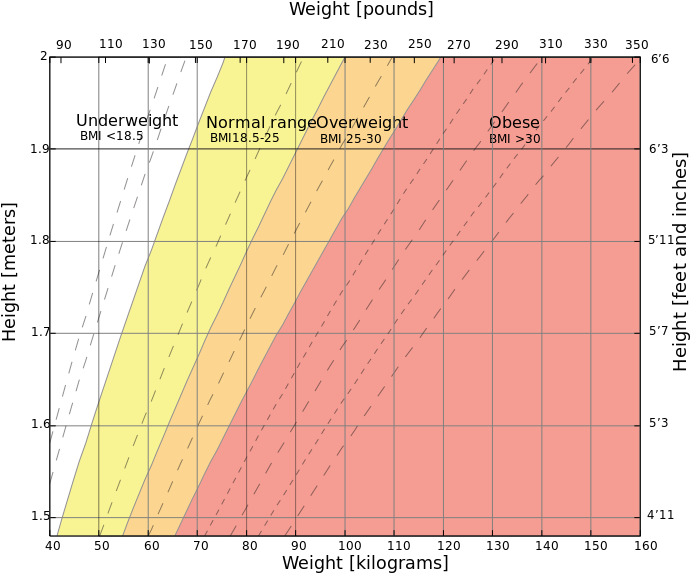BMI Calories - Free Health and Fitness Calculators -
BMI Calculator
The Body Mass Index Calculator measures your BMI which represents a relative weight based on an individual's mass and height. The BMI is used as a simple method to assess how much your body weight departs from what is normal or desirable for a person of your height. A healthy BMI measurement is between 20 and 25, while a value below 20 indicates that you may be underweight and a value above 25 indicates that you may be overweight.
Use the "Metric Units" (cm, kg) tab if you want to calculate your BMI in international metric units, or the "US standard units" are more comfortable with feet, inches and lbs units.
The referenced weight range and calculation formulas are listed below.
Results
Additional information will be displayed here once you calculate your BMI
BMI = 22.96 kg/m2 (Normal)
Normal BMI range: 18.5kg/m2 - 25 kg/m2
Normal BMI weight range for the height: 128.9 lbs - 174.2 lbs
Normal BMI height range for the weight: 128.9 inch - 174.2 inch
Ponderal Index: 12.91 kg/m3
Other Calculators
Body Mass Index Formula
The formulas used to calculate the BMI value based on two of the most commonly used measurement unit systems are:
- BMI = Weight(kg) / Height2(m2) (Metric Units)
- BMI = 703 x Weight(lbs) / Height2(in2) (U.S. Units)
BMI Table for Adults
This is the World Health Organization's (WHO) recommended body weight based on BMI values for adults. It is used for both men and women, age 18 or older.
| Category | BMI range - kg/m2 |
|---|---|
| Very severely underweight | < 15 |
| Severely underweight | 15 - 16 |
| Underweight | 16 - 18.5 |
| Normal (healthy weight) | 18.5 - 25 |
| Overweight | 25 - 30 |
| Obese Class I (Moderately obese) | 30 - 35 |
| Obese Class II (Severely obese) | 35 - 40 |
| Obese Class III (Morbid) | > 40 |
BMI Table for Children and Teens with ages between 2-20
The body mass index for children is calculated the same way as for adults, however it is then compared to values recorded for children of the same age group. As opposed to using pre-established thresholds for underweight and overweight, a BMI percentile is used to compare children of the same gender and age.
This is the "Centre for Disease Control and Prevention (CDC)" recommendation in terms of BMI categorization for children and teens with ages raging between age 2 and 20.
| Category | Percentile (%) Range |
|---|---|
| Underweight | < 5% |
| Healthy weight | 5% - 85% |
| At risk of overweight | 85% - 95% |
| Overweight | > 95% |
BMI Chart
The body mass index can also be determined using a table or from a chart which displays BMI as a function of mass and height using contour lines, or colours for different BMI categories, and may use two different units of measurement.

A graph of body mass index as a function of body mass and body height is shown above. The dashed lines represent subdivisions within a major class. For instance the "Underweight" classification is further divided into "severe", "moderate", and "mild" subclasses.
Ponderal Index & Formula
The Ponderal Index (PI), also known as Rohrer's index, is a measure of leanness of a person calculated though a formula inbetween mass and height.
PI is similar to the body mass index, but the mass is normalized with the third power of body height rather than the second power.
The ponderal index yields valid results even for very short and very tall persons, and because of
that it is most commonly used in pediatrics.
Note: The normal values for infants are about twice as high as for adults, which is the result of
their relatively short legs.
The formulas used to calculate the Ponderal Index value based on two of the most commonly used measurement unit systems are:
- PI = Weight(kg) / Height3(m) (Metric Units)
- PI = Height(in) / Weight1/3(lbs) (U.S. Units)
Global BMI Statistics by Country and Gender
In the following interactive chart we've mapped 177 countries and the average BMI of the population in each specific country. Hover over any of the available countries and you'll see the average calculated country BMI, the average male calculated BMI and the average female calculated BMI.
The data used on the chart is from researchers at the London School of Hygiene & Tropical Medicine who used UN data on population, WHO estimates of global weight, and mean height from national health examination surveys.